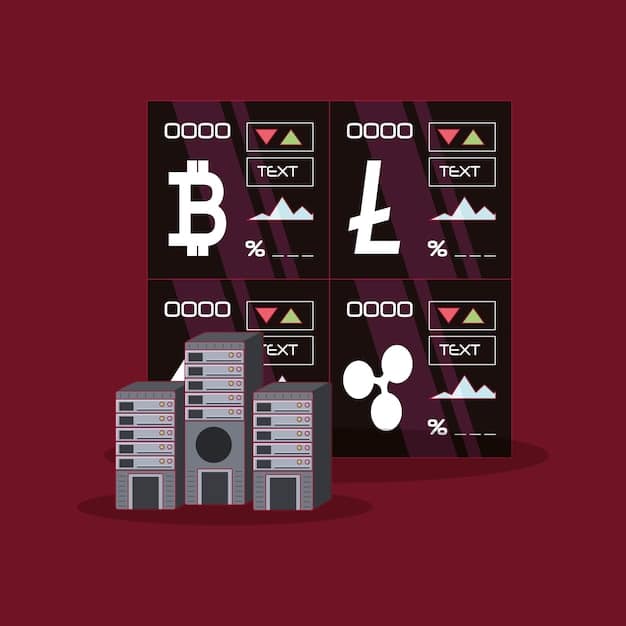Crypto Exchanges in the US: Navigating New Regulations in 2025

In 2025, crypto exchanges in the US are adapting to new regulations that impact their operations, compliance, and the overall market structure, including stricter KYC/AML rules and potential restrictions on certain crypto assets.
The landscape of crypto exchanges in the US: How New Regulations are Shaping the Market in 2025 is undergoing a significant transformation. As the digital asset market matures, regulatory bodies are implementing stricter guidelines to protect investors and ensure market integrity. This article delves into the key regulatory changes impacting crypto exchanges and how these adjustments are reshaping the market for 2025.
The Evolving Regulatory Landscape for Crypto Exchanges
The regulatory environment for crypto exchanges is constantly evolving, with new rules and guidelines being introduced regularly. Understanding these changes is crucial for exchanges to remain compliant and competitive. These regulations are not just about compliance; they’re about shaping the future of the crypto market in the US.
Key Regulatory Bodies and Their Roles
Several regulatory bodies play pivotal roles in overseeing crypto exchanges in the US. These include the Securities and Exchange Commission (SEC), the Commodity Futures Trading Commission (CFTC), and the Financial Crimes Enforcement Network (FinCEN). Each body has specific responsibilities and jurisdictions, impacting different aspects of exchange operations.
- SEC focuses on whether certain crypto assets are securities, subjecting them to securities regulations.
- CFTC regulates crypto derivatives, such as futures and options, ensuring fair trading practices.
- FinCEN is concerned with anti-money laundering (AML) and combating the financing of terrorism (CFT) within the crypto space.
Compliance with each of these bodies is not optional; it’s essential for the survival and legitimacy of crypto exchanges.

Impact of KYC/AML Regulations
Know Your Customer (KYC) and Anti-Money Laundering (AML) regulations are central to the operational framework of crypto exchanges. These regulations require exchanges to verify the identity of their users and monitor transactions for suspicious activity. The goal is to prevent illicit activities such as fraud and money laundering. The consequences of non-compliance can be severe.
Strengthened KYC/AML measures are expected to raise operational costs for exchanges but also increase investor confidence.
Challenges in Implementing Effective KYC/AML
Implementing effective KYC/AML programs poses several challenges. It requires sophisticated technology, trained personnel, and ongoing monitoring. Exchanges must strike a balance between compliance and user experience, ensuring that verification processes are not overly burdensome.
- Balancing user privacy with regulatory requirements.
- Keeping up with technological advancements in fraud detection.
- Ensuring consistent enforcement across different jurisdictions.
Addressing these challenges is crucial for maintaining a secure and compliant exchange platform.
The Debate Over Crypto as Securities
One of the most contentious issues in the crypto regulatory landscape is whether certain crypto assets should be classified as securities. The SEC has taken the position that many tokens, particularly those offered in initial coin offerings (ICOs), meet the definition of a security. This classification has significant implications for exchanges, increasing regulatory burdens.
The SEC’s stance has led to enforcement actions against exchanges that list unregistered securities, creating uncertainty in the market.
How Security Classifications Affect Exchanges
If a crypto asset is deemed a security, exchanges listing the asset must comply with securities laws. This includes registering with the SEC, implementing robust trading surveillance, and providing detailed disclosures to investors. The costs and complexities associated with these requirements can be substantial.

Future Trends in Crypto Regulation
Looking ahead to 2025, several trends are likely to shape the future of crypto regulation. These include increased international cooperation, the development of central bank digital currencies (CBDCs), and the rise of decentralized finance (DeFi).
International Cooperation and Harmonization
As crypto markets operate globally, international cooperation is essential for effective regulation. Efforts are underway to harmonize regulatory standards across different jurisdictions, preventing regulatory arbitrage and ensuring consistent enforcement. These efforts usually involve collaboration between different regulatory bodies.
- G20’s Financial Stability Board (FSB) is working on global regulatory framework for crypto assets.
- International Organization of Securities Commissions (IOSCO) is developing standards for crypto asset regulation.
- FATF (Financial Action Task Force) sets global standards for AML/CFT, which apply to crypto assets.
Increased collaboration will lead to a more stable and predictable regulatory environment for crypto exchanges.
Adapting to Central Bank Digital Currencies (CBDCs)
The emergence of CBDCs poses both challenges and opportunities for crypto exchanges. CBDCs could compete with existing crypto assets, but also provide new payment rails and use cases. Exchanges must adapt to integrate CBDCs into their platforms.
The US Federal Reserve is exploring the potential for a US CBDC, with significant implications for the crypto market.
Integrating CBDCs into Exchange Platforms
Integrating CBDCs into exchange platforms requires technical upgrades and changes to operational processes. Exchanges must ensure that CBDCs can be seamlessly traded alongside other crypto assets. They will also need to develop new risk management strategies to address the unique characteristics of CBDCs.
The Rise of Decentralized Finance (DeFi)
DeFi is one of the fastest-growing sectors in the crypto space, characterized by decentralized exchanges (DEXs), lending platforms, and other financial applications. However, DeFi also poses regulatory challenges, as it operates outside traditional regulatory frameworks. But there is an impact it has.
Regulators are examining how to apply existing laws to DeFi, while also considering new regulatory approaches to address the unique risks posed by decentralized systems.
Regulatory Approaches to DeFi
Regulating DeFi requires a nuanced approach that balances innovation with investor protection. Regulators are exploring various options, including licensing requirements for DeFi platforms, AML/KYC obligations, and consumer protection measures. It is a difficult decision.
There is no perfect choice and therefore there are many ideas for the future regulations.
| Key Point | Brief Description |
|---|---|
| 🔑 KYC/AML Compliance | Strict rules requiring user verification and transaction monitoring. |
| 🏛️ Regulatory Bodies | SEC, CFTC, and FinCEN play key roles in overseeing crypto exchanges. |
| 🌐 International Cooperation | Efforts to harmonize crypto regulations globally. |
| 🏦 CBDC Integration | Adapting platforms to include central bank digital currencies. |
Frequently Asked Questions
The main challenges include complying with KYC/AML regulations, navigating the debate over crypto as securities, and adapting to potential new rules for DeFi and CBDCs.
KYC/AML regulations require exchanges to verify users and monitor transactions, increasing operational costs but also enhancing market security and trustworthiness for investors.
The SEC considers many crypto assets, especially those from ICOs, as securities, subjecting them to securities regulations and potentially impacting exchanges listing them.
Future trends include increased international cooperation, the introduction of central bank digital currencies (CBDCs), and regulatory approaches to decentralized finance (DeFi).
International cooperation aims to harmonize regulatory standards across jurisdictions, preventing regulatory arbitrage and ensuring more consistent enforcement of rules for crypto exchanges.
Conclusion
As crypto exchanges in the US: How New Regulations are Shaping the Market in 2025, it’s clear that navigating the evolving regulatory landscape requires proactive adaptation and a strong commitment to compliance. By understanding the key regulatory changes, embracing technological advancements, and fostering collaboration with regulatory bodies, exchanges can position themselves for long-term success in the digital asset market of 2025.





